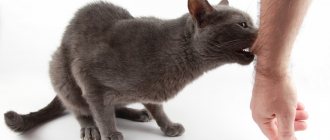10643Administration
3
Often, pet owners are faced with various behavioral problems of the latter. Cats that are naturally willful, but happily get along with people, may suddenly begin to show aggression. In fact, nothing happens for nothing, and if a cat attacks a person, then there are reasons for it. The owner of the animal can install them, but quite often only a veterinarian can do this, so do not put off going to the veterinary clinic. Especially in cases with a sharp change in the cat’s behavior.
Why does a domestic cat attack and bite its owner?
In most cases, the reason for aggressiveness lies in psychology. The animal is driven to such behavior by a wide variety of emotions. In the absence of pathology, a disgruntled cat always warns of a possible attack:
- presses ears, moving them back;
- arches tail and back;
- raises the fur along the spinal column;
- turns sideways to the enemy;
- makes hissing or rumbling sounds.
If you notice such behavior, leave your pet alone and carefully analyze what triggered it. By eliminating the irritating factor, you will avoid new outbursts of anger.
Illness or pain
If a previously affectionate cat has become aggressive and attacks its owner, then the reason for this behavior may lie in pain. A paw injured as a result of an unsuccessful landing reacts sharply to even the most gentle touches. A pet may attack a person in order to prevent contact with a sore limb.
Pain syndrome is characteristic not only of injuries, but also of some diseases: arthritis, infections, pathologies of the oral cavity. Monitor closely for accompanying symptoms. If apathy, sleep disturbances and poor appetite appear, it is better to get checked at a veterinary clinic.
Another possible cause of attack is deterioration or complete loss of functionality of one of the senses. Impaired hearing, vision and smell interfere with the normal perception of the real picture, distorting the protective function. Most often, this problem occurs in old age.
Bad Education
Frequent play with human hands becomes a habit. As a kitten ages, its claws lengthen and become sharper. The damage from such “cold weapons” is much more serious than in childhood. A mustachioed pet, accustomed to the absence of punishment, will not only play with his hands, but also take out his dissatisfaction on them.
If a cat does not like to sit in the arms of strangers, then in a noisy company she will easily release her claws at anyone who dares to touch her. This behavior is especially dangerous when a small child appears, exploring the world through touch.
Self-defense
Claws and teeth are used not only for attack, but also for defense. Aggressive behavior is explained by ordinary fear. Sudden awakening, a sharp grab or forceful holding are perceived as a threat. Most often, cats simply hiss and run away in the hope of hiding in a secluded place. If all escape routes are blocked, they will fight until victory.
It is also worth noting the protection of offspring. During pregnancy and lactation, the pet becomes more suspicious. She may bite a stranger or animal who decides to disturb her kittens.
Demandingness
Another unpleasant consequence of poor upbringing is demanding behavior through strong bites. With the help of the owner's nipping, the cat may ask to eat or play. Most often, ill-mannered pets bite a person’s legs, pushing them in the right direction. Ignoring this behavior will not solve the problem, but will only increase the force of the bite.
Psychological trauma
The protective reflex is triggered not only by a real threat, but also by a conditional one. Pets taken from the street often suffer from psychological trauma received during wandering. Experienced memories that provoke inappropriate behavior return to them when they see certain objects along with sounds or smells. In such cases, the resulting aggression is called redirected.
The worse the violence experienced, the more aggressive the possible attack. An animal that is regularly beaten with a slipper can leave serious injuries to the owner, who puts on house shoes in front of the pet.
The cause of stress is not only violent actions, but also excessive affection. If personal space is frequently violated, the cat will begin to defend its freedom.
If your mustachioed pet always grew up in care and had the opportunity for privacy, analyze recent events. He may be stressed about moving, having a baby, or having another pet. In this case, all actions are aimed at attracting the owner’s attention.
Competition with other animals
If a cat attacks another cat, then she feels a competitor in her: she is jealous of the owner or is afraid of losing her territory. Keeping multiple pets together is not an easy task. It will take time for the two mustachioed warriors to reconcile.
In such situations, it is recommended to avoid direct intervention, as the pet’s aggression will be redirected to the owner. Before you start training, wait until both pets have calmed down and are ready to cooperate.
Strangle a child
In March of this year, in the Ukrainian city of Ostrog, a cat strangled a baby. According to the Rivne Regional Center for Emergency Medical Care, a four-month-old boy was lying in a stroller without signs of life. When his parents found him, a cat was sleeping on the baby's face.
“Apparently, in this case there was no direct aggression from the cat to the child. Cats kill their victims - rodents and birds - with a bite to the neck. Here the baby slept, and the cat lay on him and blocked the access of oxygen to the respiratory tract. The child could not roll over and scare the animal by screaming. Cats are not as intellectually developed, they do not understand cause and effect relationships, and we should not expect this from them. There are also frequent stories among people when parents crushed their children while sleeping on the same bed. Sleeping adults, especially when intoxicated, have little control over their bodies and are often insensitive to their surroundings.”
, says veterinary neurologist and behavioral medicine doctor Lyudmila Konikova.
Many cats love to sleep with children. They are attracted to the warmth and smell of milk, sometimes it is just curiosity.
“Usually cats are sensitive to the condition, especially children. But anything can happen: either the cat is young and not smart enough (like people, cats are different). She’s warmed up and doesn’t want to leave, or the child is sick, and she heals him with her vibrations (while purring).”
, says the President of the International Felinological Association “Rus” (FARUS) Tamara Emelyanova.
Even if a cat slept on a child, this is not always the direct cause of his death.
“There is sudden infant death syndrome. An autopsy shows respiratory arrest. If there was a cat nearby at that moment, she will be blamed. There were cases when a child was strangled by a father who was tired of screaming, and then blamed it on the animal, says animal engineer Anastasia Kalinina. — Leaving any pet alone with a child under two years of age is not recommended. A child may unknowingly hurt an animal, and it will scratch or bite him.”
.
Cases of critical aggression
In addition to the situations discussed, uncontrolled aggression is also possible. To repay it, medical intervention is necessary. Otherwise, the animal, which finds itself in an insane state, can cause fatal injuries to people.
Unsatisfied sexual instinct
Neglect of castration and lack of mating can result in a serious problem in the future. Unsatisfied sexual instinct does not go away over the years, but constantly accumulates. As a result, in the middle or end of life, accumulated energy is redirected in a negative direction. Behavioral disorders occur, accompanied by increased nervousness and outbursts of aggression.
20 years ago, my uncastrated 9-year-old cat began to attack me, my mother, and, worst of all, my little sister for no reason. Then there was no money and ample opportunity to study why this happened, all that was left was guesswork. Later, I kept hearing from friends: an uncastrated domestic cat went crazy, caused serious injuries, and had to be euthanized. And a friend of my grandmother almost lost her arm. So castration is humane both in relation to the cat and in relation to others.
Owner Maria
The cat has gone crazy - literally
Cat madness is a rare phenomenon in veterinary medicine. In 99% of cases, aggression is associated with psychological trauma, poor upbringing, self-defense or pain. A mental disorder can only be determined using laboratory diagnostics.
If your pet attacks members of your household, make an appointment with a veterinarian. In the absence of pathologies and a stable mental state, he may need a zoopsychologist.
Rabies
The rabies virus is deadly to humans, so it is necessary to clearly know the main signs of its manifestation. When infected it is noted:
- profuse drooling;
- aggressiveness or apathy;
- fear of light and water;
- perverted appetite (eating inedible objects).
The patient should be isolated in a separate room to prevent the spread of the virus. There is no cure for this infection. The only way to protect yourself is timely vaccination.
What should an owner do if a cat bites and attacks?
You can understand what to do if a cat attacks its owner using the reason for its aggressiveness. The problem that arises can be solved by proper education or treatment.
Bring up
Regardless of the reason for the pet’s inappropriate behavior, retaliatory aggression on the part of the owner is unacceptable. Animals respond best to being ignored. If the attack occurs while playing together, demonstratively leave the room and do not come into contact with the cat until it realizes its mistake.
Education begins from the first days of the appearance of a mustachioed pet in the house. If the moment has already been missed, then more time will be required. It is more difficult for adults to overcome established habits than for kittens.
The following recommendations will be useful for retraining your cat:
- Avoid playing with your hands. Reconsider your arsenal of toys in favor of teasing fishing rods and mice that are suitable for displaying the hunting instinct.
- Don’t break away when another conflict arises. Gently remove your hand when the grip loosens and leave the room immediately.
- Buy a scratching post. Make sure the type you choose is suitable for your pet. The scratching post will not only shorten the length of the claws, but will also absorb some of the energy.
- Use a spray bottle. A jet of water is the ideal tool to prevent unwanted actions.
- Get another pet. If the cause of aggression lies in a lack of attention, then an additional playmate will quickly solve the problem.
Be patient. Over time, your efforts will definitely bring results.
Treat
If a disease is detected, the problem is eliminated after it is cured. Prolonged and frequent attacks require a mandatory check with a veterinarian.
A cat with an unsatisfied sexual instinct will have to undergo castration. If you have a mental disorder, you will need long-term drug treatment, but rabies cannot be cured. The patient will have to be isolated in a special box to confirm or refute the disease. A positive prognosis is only possible if you are vaccinated against the virus.
Signs your cat is about to become aggressive
Cat attacks happen more often than they should because many owners fail to recognize signs of impending aggression in cats.
Defensive posture
A frightened cat may adopt a submissive or defensive posture, which entails:
- Erect fur
- Tucked-in tail
- Squatting position
- Hiss
- Flattened and pointed ears
- Don't meet your opponent face to face
Offensive posture
When a cat takes this position, it tells you that it is about to attack. Avoid cats that show the following signs:
- Faces the enemy face to face
- The tail is straight and pointed downwards
- Fur costs
- Steps forward
- Looks your opponent straight in the eyes
- Growls
- Rectangular ears
How to reduce the risk of aggression and raise an affectionate animal
An affectionate animal can only grow up in a caring and loving family. Never, under any circumstances, use physical punishment. Your hands should only be associated with affection.
Try to talk with your pet often and study its habits. If dissatisfaction appears, accompanied by warning signals, do not test his patience, but immediately stop the unpleasant actions.
If a cat grows up next to a child, make sure that the child knows how to handle it carefully. Stop sudden grabbing and squeezing.
A cat bites when you pet it: the main reasons
Many cats have an unaffectionate character, let's try to find out the reason for this.
Many people get cats to care for them and pet them. But it is often discovered that the kitten does not like affection, or the craving for it goes away over time. It also happens that an adult animal does not like being touched, which, of course, the owners do not understand.
Willful and strong-willed character
Many cats have a special character, with their own quirks and advantages.
First of all, it is worth noting that cats, compared to dogs, allow themselves to be petted less, which is due to the specifics of their behavior. As a rule, the cat breed has a more capricious, majestic character. They show that they feel complete and self-sufficient, unlike dogs, who confirm with their docile nature that they are completely dependent on humans.
This behavior in cats appears from a very early age.
Gender plays a significant role
Neutered cats tend to be more affectionate.
As a rule, cats are the most affectionate among cat breeds due to their softer, more flexible nature. As for cats, they often show by their very appearance that they do not need the warmth of human hands.
On the other hand, cats can also be aggressive, for example, when feeding their babies. As for the males, among them there are many lovers of affection among neutered homebody cats.
Early separation from mother
Early separation from the mother can make the animal more aggressive.
Small kittens often do not allow themselves to be petted.
The fact is that all animals, including kittens, associate humans with danger and threat. As a rule, it is mother cats who accustom kittens to communicate with humans during the first two months of their life.
Negative experience, resentment
This behavior can be caused by many factors - harsh punishment, claw trimming, post-operative period (for example, after sterilization, castration), bathing, injections, etc.
Aggression in cats can be caused by resentment or negative experiences of the cat.
As for the postoperative state, which can cause a depressive state in the animal, it normalizes over time. This takes an average of 5 days or more (depending on the complexity of the operation and the recovery time of the body).
Under no circumstances should you use violent methods in raising your pet, otherwise he will lose trust in you. In such cases, it is useless to expect warmth from the animal. If your cat behaves badly, you can use various methods of education that are understandable to him, but more loyal, and in no case engage in assault.
“Mongrels” crave warmth and affection
They all have negative experiences from the street, they can remember a difficult life. Only the love of her owners will help her to forget. Raising a pet you have adopted needs to be done delicately. If you do everything correctly, then after a while he will be drawn to you.
https://youtube.com/watch?v=IhBcpDTBmz8
Pregnancy and feeding time
Owners must understand that during this period the cat needs peace, because feeding the cubs is her main task.
Weasel for kittens - game
Many animals perceive caresses as a signal to play.
It often happens that playful kittens perceive affection as a game. Seeing a person's hands, they strive to play. Their behavior will change over time if you buy special toys and jumpers for them.
Birth injury
There are times when a cat’s fetus comes out with difficulty during childbirth.
If you pet a cat in that area, it will not like it. In this case, it is better for the owner to stroke it in other places, for example, the withers, behind the ears. As for the spine, owners should not worry. This is a normal pathology.











